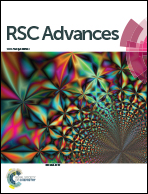Conducting collagen-polypyrrole hybrid aerogels made from animal skin waste†
Abstract
We report the synthesis of conducting collagen-polypyrrole hybrid aerogels through an in situ oxidative polymerization technique coupled with freeze drying. FTIR, XRD and SEM analysis show the complete coating of polypyrrole on the collagen molecules during the polymerization process. These low density aerogels have varying degree of flexibility, brittleness, thermal stability, porosity, biocompatibility and electrical conductivity as a function of the concentration of polypyrrole in the aerogel matrix. The maximum conductivity of the collagen-polypyrrole aerogels is found to be 3.59 × 10−4 S cm−1 for the 100/100 wt% composition. We also demonstrate the ability of the as-synthesized aerogels to conduct electrons in a light emitting diode lamp and battery setup with varying extents of brightness. The results suggest that the developed collagen-polypyrrole aerogels have potential for biosensor, tissue engineering, electrostatic discharge protection and electromagnetic interference shielding applications.


 Please wait while we load your content...
Please wait while we load your content...